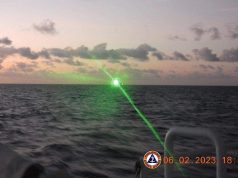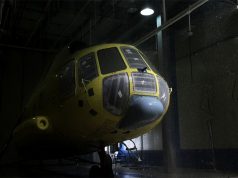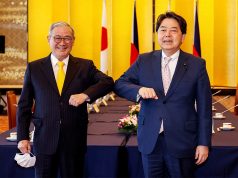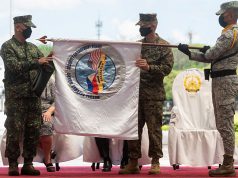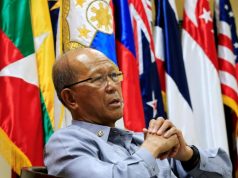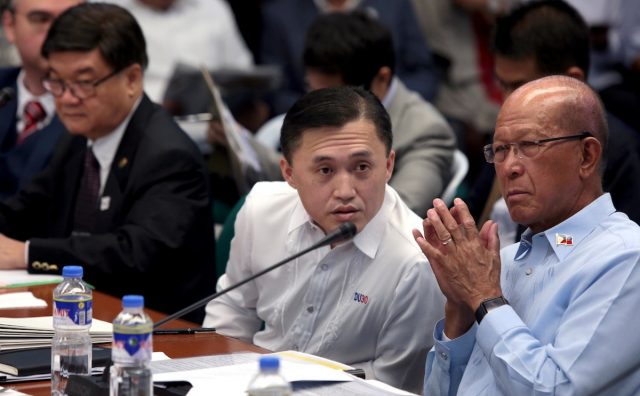
MANILA – (UPDATE2, 7:07 P.M.) The Philippine Navy (PN), through various officials, repeatedly sent letters to the officials of the Department of National Defense opposing the choice of South Korean firm Hanwha as the maker of the combat management system (CMS) to be installed in the procured frigates from Hyundai Heavy Industries (HHI).
A CMS is a computer and software system package acting as “the brain of a naval combat vessel,” the Philippine News Agency reported.
(READ MORE: TIMELINE | What we need to know: Bong Go and the P16-B Navy frigate deal
Documents gathered and presented by Senator Antonio Trillanes IV during the Senate committee hearing on Monday into the controversial P16-billion acquisition of two frigates for the PN showed that the PN had misgivings that HHI, which was pushing for Hanwha as the supplier of the CMS, was dictating upon the DND and the PN – something “grossly disadvantageous” to the PN.
The documents also revealed that Defense Secretary Delfin Lorenzana, who said that then Navy Flag Officer in Command Vice Admiral Ronald Joseph Mercado “defied” him and “usurped” his authority in preventing the PN from meeting with the people from HHI to discuss the project, directed the PN to stop sending him and other DND officials “further communications” regarding the CMS issue, and warned that “the PN’s continued trifling with the Department’s directive… will be dealt with appropriate disciplinary action.”
Lorenzana subsequently fired Mercado, saying “he is blocking the project left and right and making up some excuses.”
Here is a timeline of the standoff between the DND and the PN, based on Trillanes’ presentation.
– September 23, 2016: Netherlands firm Thales writes PN, saying it has withdrawn from a joint venture with Hanwha and is no longer connected to it. It adds that if the PN chooses Hanwha, it will be the first time for the latter to handle a project of this “complexity and size for an export customer.”
– September 23 to 30, 2016: Frigate project technical working group (TWG) states that the CMS to be chosen should be compatible with “Link-16”.
– October 24, 2016: The contract is signed. Attached is the “maker list” of the PN, which states that “TNL (Thales, Netherlands)” is its preferred combat management supplier and its “Tacticos” system is its preferred model. “Hanhwa (Thales” is also part of the maker list as another supplier. It adds that PN, as “chief owner… shall select maker”.
HHI’s maker list, meanwhile, says that “The final selection of maker to be ship builder’s (HHI) sole right as long as the equipment/systems shall fulfill the owner’s (DND/PN) requirements in building specification and other design and build aspects.”
– January 4, 2017: Mercado writes Lorenzana questioning the conditions in the HHI maker list, saying they are “grossly disadvantageous to the Philippine Navy”. He requests a meeting with HHI for clarification.
– January 12, 2017: Lorenzana forwards Mercado a “white paper” with Hanwha’s position, with the note from the Defense Secretary, “To: Admiral Mercado, Ronald, This was given to me by Bong Go. Go over it and make a report/rebuttal to be submitted to the Pres.”
– January 18, 2017: Undersecretary Lloyd Christopher Lao of the Office of the Special Assistant to the President writes Commodore Robert Empedrad, then chairman of the frigate project TWG, inviting him to a meeting in Malacañang to discuss the CMS issue on January 20.
(Lao explains during the hearing that he wrote the DND because “There are Koreans” who complained to their office, and adds that he cannot recall who those Koreans were.)
– January 23, 2017: Empedrad writes President Rodrigo Duterte, also addressing Go, saying that Thales’ Tacticos CMS is preferred because it is a leading CMS being used by 23 countries in over 170 ships; is compatible with Link-16 while Hanwha is still developing this compatibility; and has had repeat orders from some countries “indicating satisfaction”.
– February 16, 2017: Mercado writes Retired Colonel Leodegario Dela Paz, chief of the Defense Acquisition Office of the DND, asking clarification from HHI that Thales is supposedly more expensive.
– March 1, 2017: Mercado writes Dela Paz seeking the final commercial bids from Hanwha and Thales.
– March 15, 2017: Mercado writes Dela Paz saying the PN cannot endorse HHI’s CMS selection (Hanwha) for the PN frigates.
– April 11, 2017: Colonel Antonio Manggroban Jr. of the PN writes Lorenzana saying that the PN TWG, “in many discussions with HHI has already justified its selection of the CMS for the frigate in terms of being a better product and strictly compliant to the technical requirements. While HHI focused their selection on being ‘commercially advantageous,’ the PN maintains that the better CMS should be selected.” The better CMS, in PN’s opinion, is Tacticos.
– April 20, 2017: Dela Paz writes Mercado that the “Secretary of National Defense has approved the recommendation for the continuation of the abovementioned project with HHI-selected maker of the combat management system.”
– May 22, 2017: Manggroban writes Dela Paz that the PN “reiterates and affirms earlier comment that the HHI-selected Hanwha Naval Shield ICMS is not in accordance with the PN technical and build specification on the CMS.”
– August 10, 2017: Lorenzana issues a memo to AFP chief of staff tasking the Undesecretary for Finance and Materiel Raymundo Elefante to act on the implementation of the contract without delay.
– August 31, 2017: Elefante writes the AFP chief of staff, forwarding Lorenzana’s directive resolving the CMS issue.
– September 11, 2017: Then PN captain Sean Anthony Villa writes DND Assistant Secretary for Acquisition, Installation and Logistics Jesus Avilla asserting that HHI violated the Revised AFP Modernization Program or Republic Act 10349 in excluding the PN in the acquisition of major weapon and non-weapon technology.
– November 3, 2017: Undersecretary Cardozo Luna writes Mercado that Lorenzana is directing the PN “to refrain from sending further communications to the Department or from any of his subordinates relative to the CMS issue with a caution that this Department will not entertain any communications or pleadings bearing on the same issue,” and that Lorenzana “has also issued a warning that the PN’s continued trifling with the Department’s directive… will be dealt with appropriate disciplinary action.”
– November 6, 2017: Mercado responds to Luna saying the PN will proceed with the implementation of the project.
– November 28, 2017: Elefante issues a memo to Mercado saying a required document has not been submitted, and asking Mercado to explain this, or face disciplinary action.
– December 19, 2017: Mercado is relieved of his post by Lorenzana.
– January 3, 2018: Thales writes DND to again say that it has withdrawn from a joint venture with Hanwha and is no longer involved with it.
IN FINAL ANALYSIS, A QUESTION OF COST
Lorenzana said that the Thales and Hanwha CMS are “comparable” and are both compliant with the needs of the PN.
“Kaya lang, medyo branded lang ‘yung isa, ‘yung isa hindi pa (It’s just that one is a bit branded, and the other isn’t yet),” Lorenzana explained.
As he was being questioned by Senator Ralph Recto nearing the end of the hearing, Lorenzana acknowledged that Thales is “proven and tested”. Asked by Recto if the brand was the best in the market, Lorenzana replied, “Yes, yes it is.”
Ultimately, the issue boiled down to price. Choosing Thales over Hanwha would mean a difference of USD7 million per frigate, or around P350 million. Lorenzana said the DND can get the Thales CMS if it is willing to spend that much.
To which Recto replied that the budget of the AFP is around P35 billion for capital outlay, and its budget only increases year after year. He added that he has not seen the DND go through its entire budget yet in any year.
“Kung sinasabi nating malayo ang pinagkaiba ng dalawa, mas maganda ang Thales, eh bakit tayo bibili ng mas mahinang klase? …Bakit hindi natin gamitin na ‘yung pinakamaganda (If we’re saying that the two are very different from each other and Thales is the better one, then why will we buy the poor kind? …Why don’t we use the best)?” Recto asked.
Lorenzana said that Thales’ Tacticos system is used by many navies around the world, and Hanwha is used by South Korea and Malaysia currently.
But Mercado pointed out that Hanwha does not fulfill the PN’s requirement of Link 16 capability based on the contract.
Villa added, “‘Yung risk mataas. Napakataas nung risk kung titignan mo sa teknikal na aspeto… Mako-compromise po (The risk is great. The risk is so great when you look at its technical aspects… It will lead to compromise).”
Senator Risa Hontiveros said that based on her initial research on Link 16, it enables, among others, military aircraft, ship, and ground forces to exchange tactical pictures “near real time,” which, she said, “ay makaliligtas ng buhay (will save lives)”.
Mercado added that because PN “lost the right to choose” the makers, in the future, the Philippines will have ships “that will be very expensive to operate and maintain”.
Meanwhile, Lorenzana believes that there is a “concerted effort” by some to cast doubt on the frigate acquisition project, the procurement system, and the people behind it.




